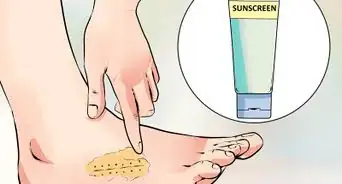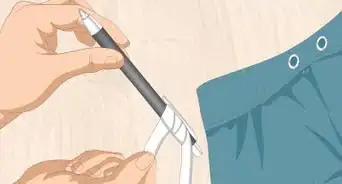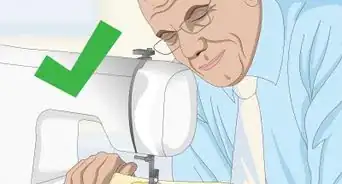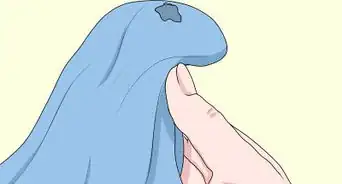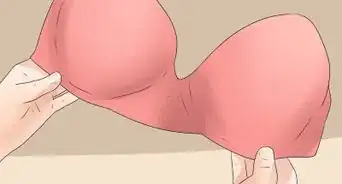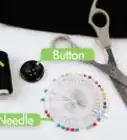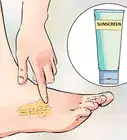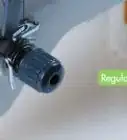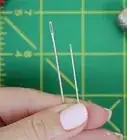This article was co-authored by Chloée Ohayon-Crosby. Chloée Ohayon-Crosby is a Costume Designer and Wardrobe Specialist in Los Angeles, California. With over eight years of experience in fashion consulting, Chloée specializes in personal, film, theater, and commercial styling as well as image consulting and costume design. Chloée has worked as an assistant designer for the distinguished fashion house Chloée and as a freelance stylist with Glamour Italia. Chloée studied Fine/Studio Arts at the Ecole Nationale Supérieure des Beaux-Arts and Fashion Design and Merchandising at the world renowned ESMOD École Supérieure des Arts in Paris, France.
wikiHow marks an article as reader-approved once it receives enough positive feedback. This article received 15 testimonials and 100% of readers who voted found it helpful, earning it our reader-approved status.
This article has been viewed 790,296 times.
Aside from scullery maids who actually made their living by darning socks, the average person may not know how to properly darn a sock. What if one of the socks in your favorite pair has developed a hole and you simply can't part with them? Well, then, you had better read this wikiHow.
Steps
Picking Your Thread
-
1Choose a thread. You will need to pick a thread that is close to the color and thickness of the existing sock yarn. You can also use a dark color for horizontal stitching and a lighter color for vertical stitching. If you have a dark sock, using white thread will help you to see what you’re doing more easily. Same goes for a white sock and dark thread. It doesn't have to match exactly; unless you are a foot model, not too many people will see your sock-covered feet.
-
2Thread the darning needle. This article says darning needle, but really it can just be a regular old needle. You will want to thread the needle with one or two strands of thread, depending on the weight of the sock. As you may have guessed, if it is a thicker sock you will want to use a thicker thread (or two pieces of thread.) Tie a knot in the end of the thread. You will begin by sewing from the inside of the sock, out, so that your knot is on the inside of your sock.Advertisement
-
3Pull the sock over the darning egg. These little darning eggs are wooden ovals that help to push the toe of the sock out so that you can see where the hole is. You can buy them at any craft store.[1]
- If you don’t have a darning egg or don’t want to buy one, you can pretty much use anything that is round. A tennis ball works well, as does a lightbulb, so long as you are very careful. You can also just use your other hand; stick it in the sock like you would your foot. This last option will make darning your sock a bit more difficult.
Darning the Sock
-
1Trim away any ragged edges. Use little sewing scissors to snip away any threads or flyaway string that are hanging from the hole. Just make sure that you don’t actually snip one too many times and make your hole even larger.
-
2Push the needle through one end of the hole. You are now going to make a large running stitch to the other side of the hole. A running stitch is the most basic of sewing stitches. All it involves is running your needle and thread up through the inside of the sock and out, then making a stitch to the right, and then pulling your needle back up and out of the sock again.
- You can also choose to sew a running stitch for a few rows above and to either side of the hole. Doing this reinforces the sewing you will be doing to close the hole up and supports the thread around the hole (which is probably pretty thin and on the verge of forming a hole itself.)
- You can also choose to sew a running stitch for a few rows above and to either side of the hole. Doing this reinforces the sewing you will be doing to close the hole up and supports the thread around the hole (which is probably pretty thin and on the verge of forming a hole itself.)
-
3Repeat your stitches. You will want to run your stitches up and over the hole, going back and forth until the hole is blocked up with parallel stitches.
-
4Sew stitches perpendicular to the parallel stitches (optional.) Creating stitches that go perpendicular to your previously made stitches will reinforce the patch you have essentially created out of thread. Weave your stitches in and out of the previous stitches.[2]
Expert Q&A
Did you know you can get expert answers for this article?
Unlock expert answers by supporting wikiHow
-
QuestionWhat's the best kind of thread to use?
 Chloée Ohayon-CrosbyChloée Ohayon-Crosby is a Costume Designer and Wardrobe Specialist in Los Angeles, California. With over eight years of experience in fashion consulting, Chloée specializes in personal, film, theater, and commercial styling as well as image consulting and costume design. Chloée has worked as an assistant designer for the distinguished fashion house Chloée and as a freelance stylist with Glamour Italia. Chloée studied Fine/Studio Arts at the Ecole Nationale Supérieure des Beaux-Arts and Fashion Design and Merchandising at the world renowned ESMOD École Supérieure des Arts in Paris, France.
Chloée Ohayon-CrosbyChloée Ohayon-Crosby is a Costume Designer and Wardrobe Specialist in Los Angeles, California. With over eight years of experience in fashion consulting, Chloée specializes in personal, film, theater, and commercial styling as well as image consulting and costume design. Chloée has worked as an assistant designer for the distinguished fashion house Chloée and as a freelance stylist with Glamour Italia. Chloée studied Fine/Studio Arts at the Ecole Nationale Supérieure des Beaux-Arts and Fashion Design and Merchandising at the world renowned ESMOD École Supérieure des Arts in Paris, France.
Costume Designer & Wardrobe Specialist
-
QuestionWhat size needle should I use?
 Chloée Ohayon-CrosbyChloée Ohayon-Crosby is a Costume Designer and Wardrobe Specialist in Los Angeles, California. With over eight years of experience in fashion consulting, Chloée specializes in personal, film, theater, and commercial styling as well as image consulting and costume design. Chloée has worked as an assistant designer for the distinguished fashion house Chloée and as a freelance stylist with Glamour Italia. Chloée studied Fine/Studio Arts at the Ecole Nationale Supérieure des Beaux-Arts and Fashion Design and Merchandising at the world renowned ESMOD École Supérieure des Arts in Paris, France.
Chloée Ohayon-CrosbyChloée Ohayon-Crosby is a Costume Designer and Wardrobe Specialist in Los Angeles, California. With over eight years of experience in fashion consulting, Chloée specializes in personal, film, theater, and commercial styling as well as image consulting and costume design. Chloée has worked as an assistant designer for the distinguished fashion house Chloée and as a freelance stylist with Glamour Italia. Chloée studied Fine/Studio Arts at the Ecole Nationale Supérieure des Beaux-Arts and Fashion Design and Merchandising at the world renowned ESMOD École Supérieure des Arts in Paris, France.
Costume Designer & Wardrobe Specialist
-
QuestionI am unable to find darning thread. What can be substituted?
 Community AnswerYou can use any thread. Try to choose one of a similar weight/thickness to the threads the sock is made from. You can use any thread you have on hand or even embroidery thread, but you would probably only need 1 or 2 strands of thread from embroidery thread. You can use yarn for wool socks.
Community AnswerYou can use any thread. Try to choose one of a similar weight/thickness to the threads the sock is made from. You can use any thread you have on hand or even embroidery thread, but you would probably only need 1 or 2 strands of thread from embroidery thread. You can use yarn for wool socks.
Warnings
- Be careful not to poke your thumb while threading the needle or stitching. You could wear a thimble or use a darning needle, which is blunt.⧼thumbs_response⧽
Things You'll Need
- Sock with a hole or worn patch
- Darning needle
- Thread to match the color of the sock
- A darning egg or similar object
References
About This Article
To darn a sock, start by picking thread that’s about the same color as your sock, then thread your needle and knot the end of the thread. Be sure to trim away any loose threads or ragged edges around the hole. Then make a running stitch across the hole by pushing your needle through one side of the hole, going under it, and pulling your needle back up through the other side of the hole. Keep making running stitches like that across the hole until your sock is mended. If you want to learn how to make perpendicular stitches to make your sock stronger, keep reading the article!
